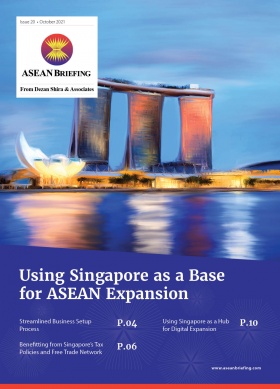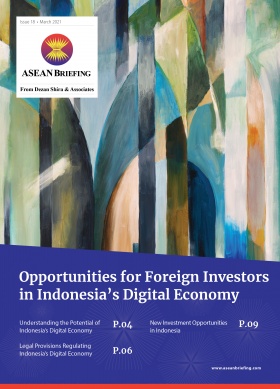Thailand Issues New Incentive Package for Electric Vehicle Industry
In February 2022, Thailand released new government incentives for its electric vehicle (EV) industry as part of its ambitious plan to transform 50 percent of its total auto production to EVs by 2030 and become a production base for cleaner vehicles in Southeast Asia. The new incentive package includes significant exemption in import duty and excise tax for a wide range of EV models, not to mention previous subsidies announced in February.
The EV incentive package reflects ASEAN’s gradual investment into environmentally friendly transportation to align with the global shift to electric vehicles by major car manufacturers. According to a 2021 EV report, the total stock of ASEAN electric-powered vehicles reached 3.4 million in 2019 and is forecasted to rise amid improving economic development, growing population, and concern for the environment.
Within Southeast Asia, Thailand has consistently ranked first in terms of total auto production output, and 11th in the 2019 global ranking. The country annually manufactures 2 million internal combustion engine vehicles for major brands, such as Toyota, Honda, and Mitsubishi. In an attempt to preserve its leading reputation in the automotive industry, Thailand plans to attract 400 billion baht (US$12.08 billion) in investments over the coming years and support the production of 1.2 million EVs and 690 charging stations by 2036.What is included in the incentive package?
The latest incentive package announced includes:
- A 40 percent reduction in import duty for completely built-up (CBU) of battery EVs priced up to 2 million baht ($61,805) and a 20 percent reduction for those priced between 2 million ($61,805) and 7 million baht (US$211,278) from 2022 to 2023; and
- Excise tax cut from 8 percent to 2 percent for imported EVs, which is predicted to add 7,000 EVs in the first year.
The incentives will initially apply to some 27 model types of EVs comprising of:
- Eco-cars with 10 seats or less;
- Electric pickups;
- Hydrogen fuel cell-powered trucks;
- EVs with 10 seats or less; and
- Plug-in four-door passenger pickups.
The package is a follow-up to earlier February subsidy programs to encourage EV production and purchases, which include:
- A 70,000 baht (US$2,111) subsidy is available per EV unit for passenger cars with 10 to 30 kWh battery capacity for completely knocked-down (CKD) and CBU units;
- A 150,000-baht (US$4,523) subsidy for each EV unit for passenger cars with more than 30kWh battery capacity for completely knocked-down (CKD) and CBU units;
- An 18,000-baht subsidy for electric motorcycles from eligible car producers between 2022-2023; and
- Exemption of import duties on important electrical components: batteries, traction motors, compressors for battery EVs, battery management systems, drive control units, and reduction gear between 2022-2025.
The subsidy programs are funded by 3 billion baht (US$90.4 million) from the 2022 central budget and from the longer-term 40-billion-baht (US$1.2 billion) investment in the EV industry between 2023 – 2025.
What are the challenges facing Thailand’s EV industry?
The country is keen to play a key part in becoming a hub for EV production, however, there are challenges facing manufacturers. These range from insufficient infrastructure to financial barriers.
Insufficient EV infrastructure
Insufficient EV infrastructure development is one barrier to Thailand developing a holistic EV manufacturing industry. According to the Bangkok Post, the country could take up to a decade to produce EVs effectively since existing supply chains are tailored towards manufacturing parts and bodies for vehicles with internal combustion engines (ICE).
There is also a lack of charging stations throughout Thailand, with only 1,000 or so public charging points compared to around 30,000 gas stations — there is also a lack of home charging stations. Further, many Thai consumers are concerned about EV performance barriers including reliability, batter lifespan, range, engine power, and charging time.
However, since early 2022, several private sector entities such as PTT Oil and Retail Business and Eppo are looking to invest in charging stations in the country.
Financial barriers
High purchase costs, battery costs, and resale value are also barriers for Thailand’s EV industry — compared to ICE vehicles, EVs are often more expensive due to the lack of an economy of scale. Moreover, a significant portion of the total EV costs is battery costs, and capacity increase with size, type, and range.
While other ASEAN countries, such as Indonesia and the Philippines, are important global sources of nickel, such deposits are not as large in Thailand, meaning there could be a potential material supply shortage to produce the lithium-ion batteries used in electric vehicles.Another challenge lies in the government’s targeted approach to focusing on BEVs in its EV policy. As was earlier mentioned, certain incentives, such as the latest reduction in import duties, only apply to BEVs. However, investors should be cautious as analysis shows limited interests in BEVs despite the government leverage. In 2021, the number of new registrations for BEVs approximated 1,900 units, a significantly small fraction compared to the 38,600 newly registered hybrid electric vehicles (HEV)s and plug-in hybrid electric vehicles (PHEVs). Investors should also keep in mind the novelty and complexity of BEVs’ technology that in a relative infant EV industry is difficult to mass-produce in Thailand.
What factors support Thailand’s ambitions to build an EV production hub?
Despite the challenges, there are several factors that support Thailand’s ambitions to be an EV production hub. In addition to government incentives, a well-developed logistics network and supporting infrastructure can help propel the EV industry.
The introduction of the latest incentive packages shows that Thailand is eager to build an advanced EV production hub and industry in Southeast Asia. Experience from Nordic countries like Norway and Sweden have demonstrated the potential of generous tax schemes in attracting international EV manufacturers, which is exemplified by Norway’s US$3 billion EV tax subsidies that laid the ground for the impressive EV domestic market share of more than 55 percent. A study on the impacts of US federal EV subsidies has also concluded that “without tax subsidies, EV purchases would have fallen by about 29 percent.”
Attractive incentives continue to help
While Thailand’s economic capacity is not on par with that of Northern Europe nor the US, its ambitious and concrete government actions could promise an optimistic forecast for the EV industry. Many countries like Germany, China, and Israel have already been inclined to open EV battery plants in Thailand. The subsidies are also causing demand to surge over time.
As the most prominent ASEAN EV market, in 2020, Thailand recorded 2,854 EV registrations, within which were 1,572 new cars, a record-breaking 380 percent increase from 2018. In 2021, besides the cumulative 219,044 hybrid and plug-in hybrid EVs, new EV registrations reached 5,781 – according to the Electric Vehicle Association of Thailand (EVAT). These figures clearly prove the effectiveness of consistent government incentives since Thailand issued its official EV policy in 2017.
Short-term boost due to high gas prices
Thailand’s EV industry might also benefit in the short term from soaring gas prices, which have continued to increase due to the escalating Ukraine – Russia crisis. Electric vehicles could potentially emerge as an economical transportation alternative to fuel-driven vehicles. Although 55 percent of Thailand’s electricity continues to be powered by natural gas, the country currently reserves 4.9 trn cubic feet of natural gas to secure a self-sufficient supply while promoting the use of renewable energy in the Power Development Plan 2018-2037.
Strategic location and well-developed infrastructure
Thailand’s position as the number one automotive exporter in the region is enhanced by its strategic position at the heart of mainland ASEAN, a market of more than 600 million and a growing middle-class.
Thailand’s Eastern Economic Corridor, which is the country’s industrial and economic heartland, is already home to leading carmakers and components provides an environment that supports the development and scaling of new innovations in the EV industry.
The country’s Laem Chabang Port, the world’s third-largest gateway port and the 20th busiest in the world is to begin its Phase 3 expansion that will see the port have a container throughput capacity of 18 million twenty-foot equivalents (TEU) per year by 2029. Under Phase 3, the port will increase car exports from 2 million units to 3 million units per year.
Further Reading
- Thailand and the EU Resume Free Trade Agreement Negotiations
- High-Tech in Thailand: Incentives for R&D, Semiconductors, and Smart Packaging
- Thailand’s Laem Chabang Deep Seaport to Begin Phase 3 Expansion
About Us
ASEAN Briefing is produced by Dezan Shira & Associates. The firm assists foreign investors throughout Asia and maintains offices throughout ASEAN, including in Singapore, Hanoi, Ho Chi Minh City, and Da Nang in Vietnam, Munich, and Esen in Germany, Boston, and Salt Lake City in the United States, Milan, Conegliano, and Udine in Italy, in addition to Jakarta, and Batam in Indonesia. We also have partner firms in Malaysia, Bangladesh, the Philippines, and Thailand as well as our practices in China and India. Please contact us at asia@dezshira.com or visit our website at www.dezshira.com.







